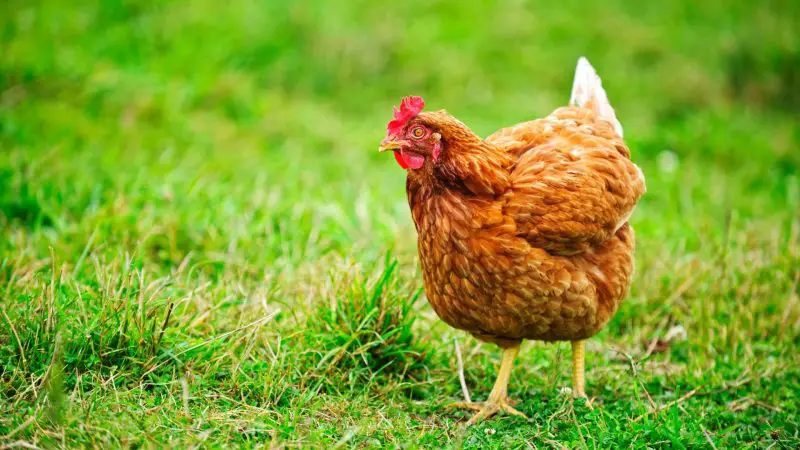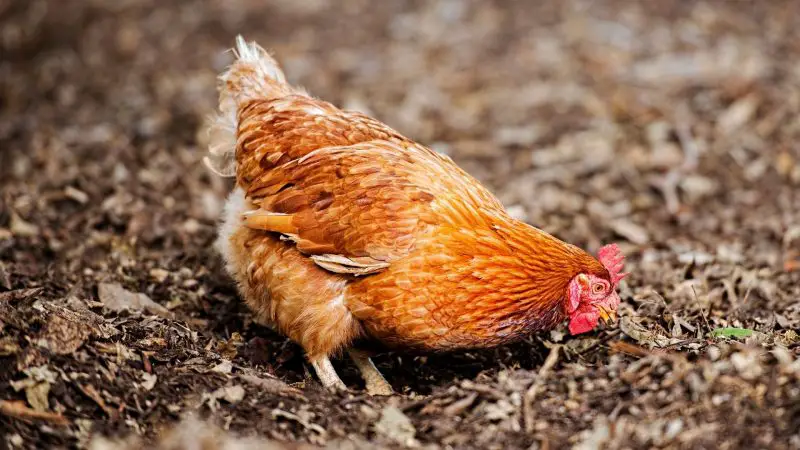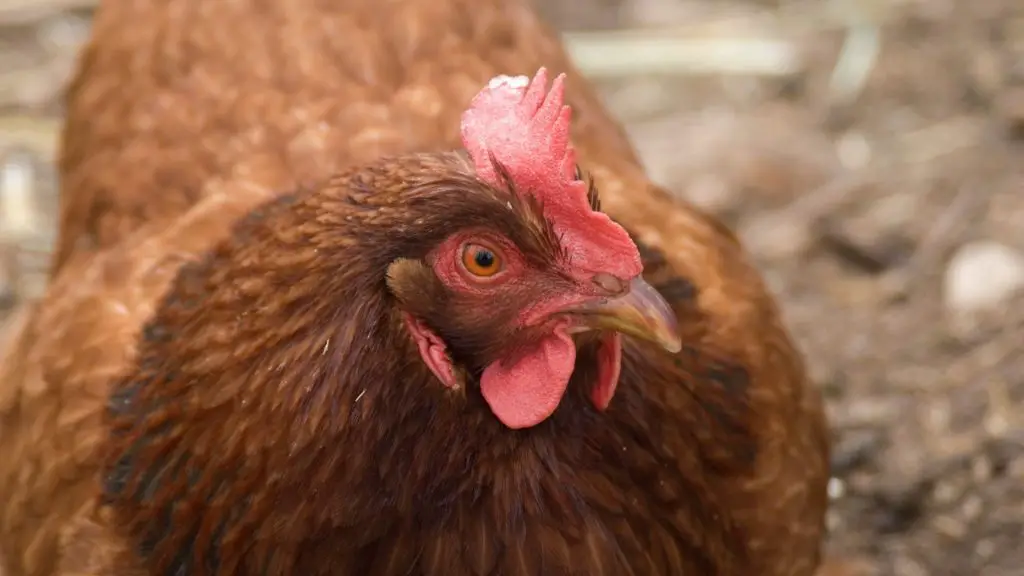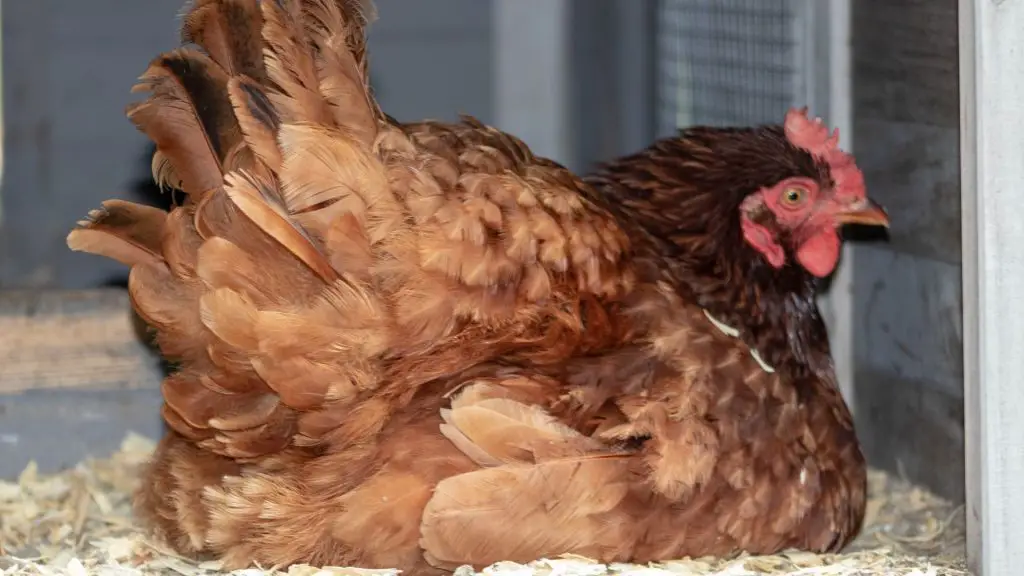Given the many breeds of chickens out there, choosing the right ones for your needs can be challenging. You’ll need to figure out a way to narrow down your list of options – and one way to do so is choosing chickens of the same color! If you’ve decided to opt for red chickens, you may be wondering which breed options you have to select from.
Here are seven major breeds of red chickens:
1. Rhode Island Red
2. ISA Brown
3. Whiting True Green
4. Nankin Bantam
5. Welsummer
6. New Hampshire Red
7. Production Red
Take a closer look at these breeds and what you can expect when raising each one of them!
Seven Major Breeds of Red Chickens
1. Rhode Island Red

When you think about red chickens, the first image that pops into your mind is probably that of a Rhode Island Red. These chickens were first bred in Rhode Island and New England – hence their name – and are the state birds of Rhode Island. The American Poultry Association first recognized them in 1904.
They are considered ideal for people looking to raise chicken in their backyards and are also a common sight on farms worldwide. While they have been popular since the early 1900s, this popularity exploded in the post-war years.
This is because, since the 1940s, the Rhode Island Red has been selectively bred for its egg-laying capabilities. Today, the breed can produce between 150-300 eggs a year, making it the perfect option if you’re looking for a layer breed. Additionally, its meat is rich, and Rhode Island Reds are often raised as dual-purpose chickens for both eggs and meat.
2. ISA Brown

Despite their name, ISA Browns are, in fact, red chickens – the ‘brown’ in their name comes from the color of eggs they lay.
They are crossbreeds made of different chicken breeds, including Rhode Island Reds and Rhode Island Whites. However, their exact genetic makeup remains a secret closely guarded by the Institut de Sélection Animale, the company that developed the breed. The ‘ISA’ part of the name is an abbreviation of the company’s name.
Like Rhode Island Reds, ISA Browns are mainly raised for their egg-laying capabilities – they can lay up to 300 eggs a year. They’re also personable and docile, making them an excellent option for first-time chicken owners.
These chickens are sex-linked, which means that you’ll easily be able to distinguish the males from the females when they hatch due to their color differences.
3. Whiting True Green
Like ISA Browns, these chickens aren’t named for their coloration – rather, they are named for the color of their eggs.
A relatively new breed, they were developed by Dr. Tom Whiting – from whom they get their name – to help produce feathers ideal for fly fishing.
As with the two other breeds mentioned on this list, Whiting True Greens are, first and foremost, bred for their egg-laying capabilities. They produce medium-sized olive green eggs and lay about 300 of them a year.
Additionally, it has a great feed-to-egg conversion ratio, so you can be confident that you’re getting great bang for your buck. They’re also non-setters, which helps increase their attractiveness as layer birds. They do best in free-range environments.
4. Nankin Bantam
Nankin Bantams are true bantam chickens and do not have a large counterpart from which the smaller version was developed. They are thought to be among the oldest true bantam breeds and became widespread in the West in the 18th century.
The Nankin Bantam has been used as a base to develop several other, more common bantam chicken breeds, including the Sebright.
They are a rare, vintage chicken breed. They are listed as ‘Critical’ on the list of endangered chicken breeds created by the Livestock Conservancy and the Food and Agriculture Organization of the United Nations.
Nankin Bantams have been recognized by the American Poultry Association, though they are extremely rare in the United States.
These chickens are most commonly raised as show birds – they are poor meat producers and produce small eggs.
They are broody birds, so if you’re looking for chickens that will help raise a new crop of baby chicks, they’re a great choice. They’re also a good option if you’re looking for help incubating the eggs of other game birds, including pheasant and quail.
These birds are calm and personable, making them a good option if you’re looking to raise chickens in your backyard.
There are two major Nankin Bantam varieties, distinguished by their combs. One has a five-pointed comb, while the other has a single-pointed comb.
5. Welsummer
The Welsummer is a Dutch chicken breed. These chickens are best known for their terracotta-colored speckled eggs.
The chickens have a docile and friendly temperament and are very hardy and able to deal with the cold well. They are extremely intelligent and are good foragers, so they are a good option if you’re looking to raise free-range chickens.
Welsummers were bred from several breeds of chickens, including Rhode Island Reds, Cochins, and Wyandottes. The hens can usually be identified thanks to the hints of gold around the neck, while males have golden-brown feathers on their saddle, head, and neck.
While they’re suitable for meat production, they are most commonly raised for their egg-laying qualities. In the early 1920s, their eggs were initially exported as part of the commercial egg trade.
They lay about 160-200 eggs a year. These breeds are occasionally broody and are setters. Welsummers are relatively common in Europe but are rarer in the United States.
6. New Hampshire Red

New Hampshire Reds were first bred in the state of New Hampshire, which is where they got their name from. They are a result of the selective breeding of Rhode Island Reds – the characteristics that this process focused on, including the production of larger eggs and rapid full feathering.
It was first developed in the early 1900s and was named the State Poultry of New Hampshire in 2018.
This chicken is a dual-purpose breed and is bred for either its egg-laying or meat-producing abilities. It lays about 280 eggs a year. However, despite its prolific egg-laying, it is most popular for its meat.
New Hampshire Reds are good settlers and can be very broody, so they make for good mothers. They show a wide variety of temperaments, ranging from docile to aggressive, so they may not be the best choice if you only have shyer breeds in your current flock.
Additionally, they can be food aggressive, though it is possible to reduce this behavior by ensuring several feeding stations are available, all spread out from each other.
7. Production Red

Another chicken breed is known for its egg-producing abilities (hence their name). Production Reds are usually crossbreeds between New Hampshire Reds and Rhode Island Reds.
However, depending on the hatchery you get your chickens from, you may also find Production Reds, a cross between Rhode Island Reds and other breeds, including Rhode Island Whites.
Like their progenitors, they are a dual-purpose breed and can be raised for either their meat or egg-laying capabilities. They lay between 240-300 eggs a year, making them an excellent option for people looking to maximize the eggs produced by their flock.
While the birds look relatively similar to Rhode Island Reds, they are lighter in color. They are docile, calm, and friendly and make for a great option for people looking to add to – or start – a backyard flock (though they can also be used in commercial hatcheries and flocks).
Related: What Kind of Chicken Do I Have? | Chicken Breeds
List of Sources
Chicken Breed Chart to Help You Choose Your Chicken
Importance of Individual Feed Records in Breeding for Feed Efficiency in Layer-Type Chickens
